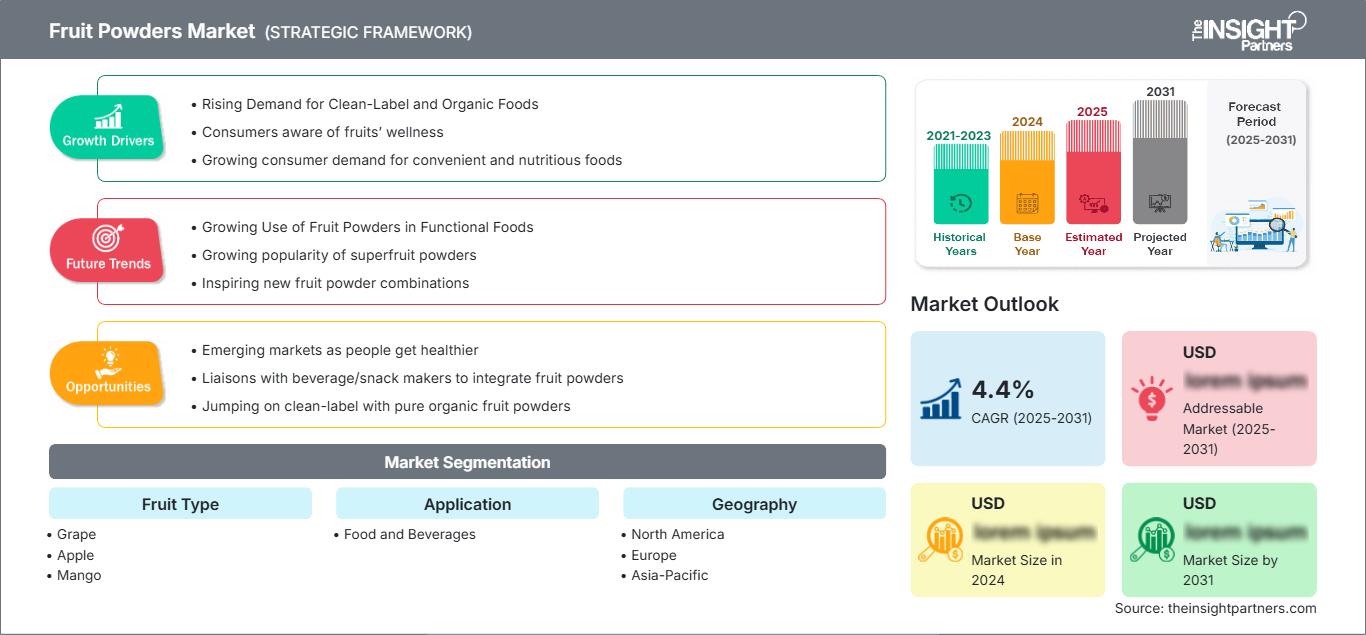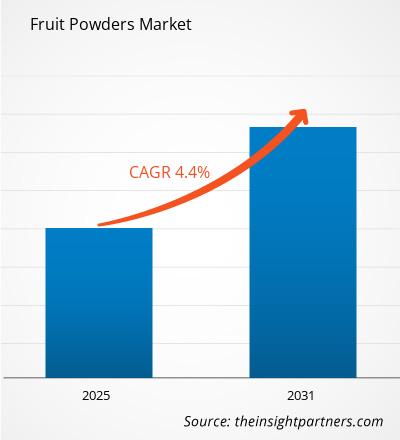The Fruit Powders Market is expected to register a CAGR of 4.4% from 2025 to 2031, with a market size expanding from US$ XX million in 2024 to US$ XX Million by 2031.
The report "Fruit Powders market" illustrates the demand arising for natural fruit powders from various food and beverage applications, impelled by health-aware consumer trends. In addition, detailed insight into the analysis of market dynamics, growth potential, coupled with regional trends and the competitive landscape and key players, is given. Dietary supplements and functional foods are some of the key applications that showcase opportunities for growth and innovation to stakeholders.
Purpose of the Report
The report Fruit Powders Market by The Insight Partners aims to describe the present landscape and future growth, top driving factors, challenges, and opportunities. This will provide insights to various business stakeholders, such as:
- Technology Providers/Manufacturers: To understand the evolving market dynamics and know the potential growth opportunities, enabling them to make informed strategic decisions.
- Investors: To conduct a comprehensive trend analysis regarding the market growth rate, market financial projections, and opportunities that exist across the value chain.
- Regulatory bodies: To regulate policies and police activities in the market with the aim of minimizing abuse, preserving investor trust and confidence, and upholding the integrity and stability of the market.
Fruit Powders Market Segmentation
Fruit Type
- Grape
- Apple
- Mango
- Banana
- Strawberry
Application
- Food and Beverages
You will get customization on any report - free of charge - including parts of this report, or country-level analysis, Excel Data pack, as well as avail great offers and discounts for start-ups & universities
Fruit Powders Market:
Personalice este informe según sus necesidades
Disfrutará de la personalización gratuita de cualquier informe, incluyendo partes del mismo, análisis por país y un paquete de datos de Excel. Además, podrá aprovechar excelentes ofertas y descuentos para startups y universidades.
Mercado de polvos de frutas: Perspectivas estratégicas

-
Obtenga las principales tendencias clave del mercado de este informe.Esta muestra GRATUITA incluye análisis de datos, desde tendencias del mercado hasta estimaciones y pronósticos.

-
Get Top Key Market Trends of this report.This FREE sample will include data analysis, ranging from market trends to estimates and forecasts.
Fruit Powders Market Growth Drivers
- Rising Demand for Clean-Label and Organic Foods: People are now looking for organic/chemical-free food items, fruit powder (especially organic ones) serves this need.
- Consumers aware of fruits’ wellness: As the consumer becomes more aware of the healthful attributes of fruits, fruit powders loaded with vitamins, antioxidants, and fiber are considered healthy options for the food and beverage industry.
- Growing consumer demand for convenient and nutritious foods: Fruit powders are convenient products to eat the fruits’ nutritional content and appeal to health-conscious consumers seeking simply to mix and match nutrition options.
- Growing consumption of smoothies and meal replacements: Fruit powders are used more in smoothies, protein shakes, and meal replacements, a favorite of fitness enthusiasts and consumers who want a fast and healthy meal.
Fruit Powders Market Future Trends
- Growing Use of Fruit Powders in Functional Foods: Increasingly, there is more and more use of fruit powders in functional foods and beverages like protein bars, snacks and beverages targeted to health benefits (e.g., energy, digestion).
- Growing popularity of superfruit powders: Superfruits such as acai, goji, and pomegranate are becoming popular as powder because of the high content of nutrients and other beneficial factors.
- Inspiring new fruit powder combinations: Consumers are demanding for more choice and customized health properties, so fruit powder combinations are evolving in which different fruits are blended with functional components like probiotics and adaptogens.
Fruit Powders Market Opportunities
- Emerging markets as people get healthier: With health and wellness sweeping the world, emerging markets, especially Asia and Latin America are the most promising locations to launch fruit powders.
- Liaisons with beverage/snack makers to integrate fruit powders: Liaisons with beverage/snack makers or supplement makers will allow fruit powders to be added to new products.
- Jumping on clean-label with pure organic fruit powders: Pure organic fruit powders made from simple ingredients, containing no preservatives or additives can appeal to a growing number of people who are demanding transparency and food that is healthier.
Fruit Powders Market Regional Insights
The regional trends and factors influencing the Fruit Powders Market throughout the forecast period have been thoroughly explained by the analysts at The Insight Partners. This section also discusses Fruit Powders Market segments and geography across North America, Europe, Asia Pacific, Middle East and Africa, and South and Central America.
Fruit Powders
| Atributo del informe | Detalles |
|---|---|
| Tamaño del mercado en 2024 | US$ XX million |
| Tamaño del mercado por 2031 | US$ XX Million |
| CAGR global (2025 - 2031) | 4.4% |
| Datos históricos | 2021-2023 |
| Período de pronóstico | 2025-2031 |
| Segmentos cubiertos |
By Tipo de fruta
|
| Regiones y países cubiertos |
Norteamérica
|
| Líderes del mercado y perfiles de empresas clave |
|
| Report Attribute | Details |
|---|---|
| Market size in 2024 | US$ XX million |
| Market Size by 2031 | US$ XX Million |
| Global CAGR (2025 - 2031) | 4.4% |
| Historical Data | 2021-2023 |
| Forecast period | 2025-2031 |
| Segments Covered |
By Fruit Type
|
| Regions and Countries Covered |
North America
|
| Market leaders and key company profiles |
|
Fruit Powders Market Players Density: Understanding Its Impact on Business Dynamics
The Fruit Powders Market is growing rapidly, driven by increasing end-user demand due to factors such as evolving consumer preferences, technological advancements, and greater awareness of the product's benefits. As demand rises, businesses are expanding their offerings, innovating to meet consumer needs, and capitalizing on emerging trends, which further fuels market growth.

- Get the Fruit Powders Market top key players overview
Key Selling Points
- Comprehensive Coverage: The report comprehensively covers the analysis of products, services, types, and end users of the Fruit Powders Market, providing a holistic landscape.
- Expert Analysis: The report is compiled based on the in-depth understanding of industry experts and analysts.
- Up-to-date Information: The report assures business relevance due to its coverage of recent information and data trends.
- Customization Options: This report can be customized to cater to specific client requirements and suit the business strategies aptly.
The research report on the Fruit Powders Market can, therefore, help spearhead the trail of decoding and understanding the industry scenario and growth prospects. Although there can be a few valid concerns, the overall benefits of this report tend to outweigh the disadvantages.
- Análisis histórico (2 años), año base, pronóstico (7 años) con CAGR
- Análisis PEST y FODA
- Tamaño del mercado, valor/volumen: global, regional y nacional
- Industria y panorama competitivo
- Conjunto de datos de Excel
Informes recientes
Informes relacionados
Testimonios
Razón para comprar
- Toma de decisiones informada
- Comprensión de la dinámica del mercado
- Análisis competitivo
- Información sobre clientes
- Pronósticos del mercado
- Mitigación de riesgos
- Planificación estratégica
- Justificación de la inversión
- Identificación de mercados emergentes
- Mejora de las estrategias de marketing
- Impulso de la eficiencia operativa
- Alineación con las tendencias regulatorias






















 Obtenga una muestra gratuita para - Mercado de polvos de frutas
Obtenga una muestra gratuita para - Mercado de polvos de frutas